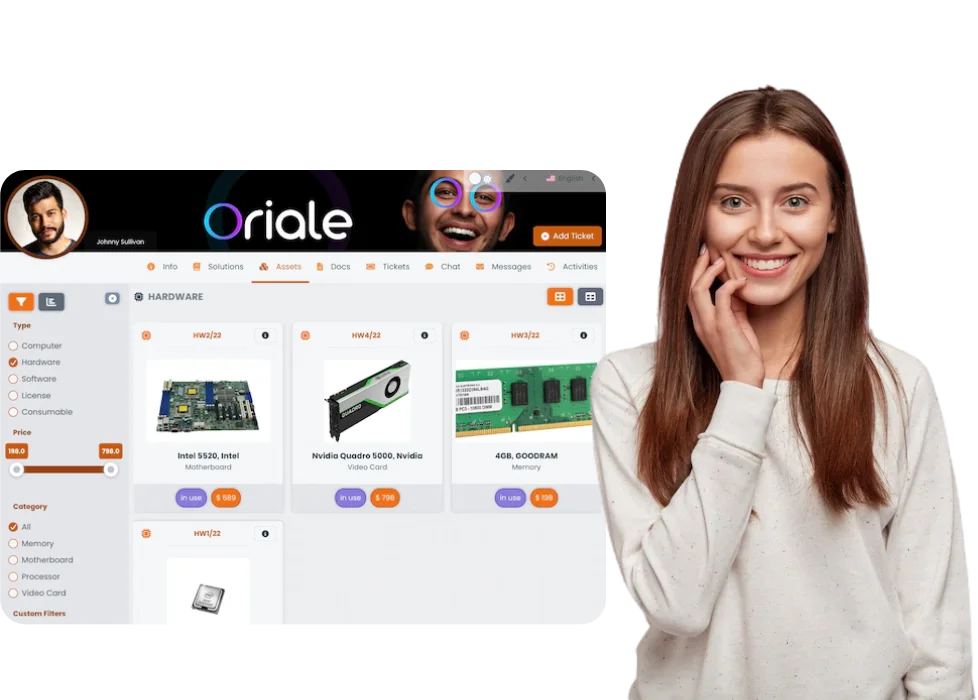| Plus | Enterprise |
| 54 USD/month for 2 licenses
| 81 USD/month for 2 licenses
|
Would you like to receive special offers?
Create a Free Business Account
SaaS licenses for the Codenica ITSM + ITAM system support concurrent licensing. This means a single account can be shared among multiple users (agents), but only one active session per account is allowed at any given time across all devices - desktop, tablet, or phone. To allow multiple users to work simultaneously, simply purchase additional, separate accounts.

Currently available software language versions
Monthly license fees for user accounts in the application.
Features available from a single license
Core features available with a single license. Prices for annually billed licenses.
Custom application domain. Hosting the application under your own company domain.
Custom application database. Connecting your own database hosted within your company’s infrastructure, with all data stored on your side.
Custom file repository. Connecting your own file storage located within your company’s infrastructure, with all files stored on your side.
License prices and discounts for larger volumes
10% discount when purchasing 2 licenses
| Plus | Enterprise |
| 54 USD/month for 2 licenses
| 81 USD/month for 2 licenses
|
15% discount when purchasing 3 licenses
| Plus | Enterprise |
| 76.50 USD/month for 3 licenses
| 114.75 USD/month for 3 licenses
|
20% discount when purchasing 4 licenses
| Plus | Enterprise |
| 96 USD/month for 4 licenses
| 144 USD/month for 4 licenses
|
25% discount when purchasing 5 licenses
| Plus | Enterprise |
| 112.50 USD/month for 5 licenses
| 168.75 USD/month for 5 licenses
|
30% discount when purchasing 6 and more licenses
| Plus | Enterprise |
| Pricing depends on the number of licenses - 30% discount | Pricing depends on the number of licenses - 30% discount |
Limits increased with each additional license
Inventory / Configuration Items (Asset Management). Each account extends your inventory and configuration item limits, allowing detailed tracking of clients/employees, assets, documents, and vendors. You can freely allocate these limits across your inventory elements.
* You can also extend these limits with the Inventory Add-On Pack, independent of the type and number of accounts you hold.File Storage. Each account increases your storage capacity within a secure, private Microsoft Azure cloud repository, ensuring safe management of your data.
* You can further expand storage limits with the File Storage Add-On Pack, which is independent of the type and number of accounts you hold.Chat & Messages Archive. Each account increases the storage limits for recent chats and messages. When limits are exceeded, the oldest entries are automatically replaced with newer ones.
* You can also expand these limits with the Communication Add-On Pack, independent of the type and number of accounts you hold.Knowledge Base Articles. Each account expands your capacity for creating and storing Knowledge Base articles.
* Additional storage can be acquired through the Knowledge Base Add-On Pack, independent of your account type or quantity.Automation. Define custom automation rules for creation, editing, or deletion of any items (Assets, Clients, Tickets, etc.). Schedule automated daily, weekly, or monthly tasks.
Teams, Emails, and Custom Fields. Organize agents into teams, configure custom properties for Assets, Clients, Tickets, etc. Automatically convert emails into tickets and manage email communications seamlessly.
Task Management. Manage tasks efficiently: assign agents, update statuses, and monitor completion times.
Help Desk - Basic Incident Handling. Manage service tickets (Requests, Incidents) effectively. Handle various requests such as IT support, complaint management, customer support, or internal employee assistance. Link tickets with related tasks, assets, notes, or other tickets.
Help Desk - Advanced Service Request Handling. Manage complex service requests by linking them to requested items and approval workflows.
Service Desk. Comprehensive management of Changes, Problems, and Releases according to ITIL best practices.
Add-On Packs increase data limits. All add-on packs are independent of the subscription plan and the number of accounts owned.
System capabilities offered with each license type.
Access Management
Each agent account supports concurrent licensing, meaning it can be shared by multiple users, but only one session per account can be active at any given time. To allow simultaneous work by multiple agents, simply purchase additional agent accounts.
Agent and Administrator roles.
The Free Viewer role offers read-only access.
Access all system modules from any device (phone, tablet, computer, etc.).
Work Management
Custom Automation Rules.
Real-time data updates on all devices (phones, tablets, computers, etc.).
Collision detection system.
Grid view, table view, and detailed view.
Bulk data editing and deletion.
Creating relationships between any items in the asset management.
Multiple teams.
Watcher mode.
Asset Management
Client and employee management.
Asset management, asset tracking, inventory management, and managing any company assets.
Document management (invoices, warranty documents, and any contracts).
Vendor management.
Tree view asset management panel.
Creation and editing of custom assets in the asset management.
Role-based access control (RBAC).
Live Chat
Chat with other support agents.
Chat with clients and employees.
Sidebar chat tool.
Messaging System
Messages sent to other agents.
Messages sent to clients and employees.
Mass messaging.
Client Portal
Support for external clients or employees.
Access from any device (phone, tablet, computer, etc.) without the need to install additional software.
Client portal personalization.
Live chat.
Messaging system.
Knowledge base (read-only).
Assigned assets in the asset management (read-only).
Assigned documents in the asset management (read-only).
Help desk ticketing system.
Client and employee activity data.
Client portal access rights.
Client portal branding.
No visibility of any Codenica software vendor data.
Knowledge Base
Knowledge base for agents.
Knowledge base for clients and employees.
Agent access configuration.
Client portal access configuration.
Ticketing System
Incident ticket handling.
Service request ticket handling.
Requested item ticket handling.
Ticket approval handling.
Configurable ticket properties.
Assets and documents assigned to tickets.
Related ticket handling.
Conversation logs with the client within the ticket, additionally sent by email.
Using canned responses from the knowledge base in ticket replies.
Public and private notes.
Managing tasks within tickets.
Managing time within tickets.
Logging activities within a ticket.
Agent access configuration using role-based access control (RBAC).
Ticketing system on the client portal.
Service Desk for Enterprise
Configurable properties.
Assigning inventory assets and documents.
Handling associations.
Notes.
Change approvals.
Change planning.
Problem analysis.
Permanent and workaround solutions.
Release planning.
Task management.
Time management.
Activity logging.
Agent access configuration using role-based access control (RBAC).
Security
Private and isolated databases for each company in Microsoft Azure, with no external access.
Secure file storage in private and isolated Microsoft Azure repositories, protected by dynamically generated keys at variable time intervals.
1. What Does It Mean That Each Account Increases the Limits?
This means that by subscribing to, for example, two Starter accounts, the number of available inventory items is doubled:
2 x 10,000 = 20,000 inventory items.
Purchasing a third account increases this number to:
3 x 10,000 = 30,000 inventory items.
Each subscription account increases limits differently (as detailed at the top of the pricing page), so three Plus accounts would be:
3 x 25,000 = 75,000 inventory items.
This progressive increase in limits per account also applies to all other limits.
2. What Are the Additional Packages For?
To provide maximum software functionality even in the lowest Starter subscription plan, we developed a payment system where the buyer decides which features to use and pay for. This allows even small businesses to use a modern system without incurring high costs.
Small businesses can start with one Starter account subscription and share one account among several people (not simultaneously - this is a concurrent access license). Only when their customer base grows can a company dynamically increase the number of user accounts (agents) it holds. When the registered resources exceed the limits, they can be easily expanded through additional Inventory packages. Each package increases the limit and enables the use of those items.
If the company or its customers upload a lot of files to the cloud, it becomes necessary to extend the license with additional File Storage packs.
The same applies to additional Communication packs - if existing limits are too low and more space is needed for correspondence archives, invest in this pack.
Similarly with the Knowledge Base add-on pack - if more articles are needed, invest in the pack.
This approach allows very flexible cost management for the application, ensuring that you only pay for what you use.
3. What Is a Free Viewer Account?
The Viewer account is a free account that operates like other accounts in shared access mode, meaning it can be run on any device by any number of people (but not simultaneously). This account allows view-only access to data, meaning no changes can be made to the system. This type of account is most commonly used by management or the accounting department.
4. Is the Number of Tickets Limited?
No, the fee for an unlimited number of tickets is already included in the subscription account fee. Therefore, you do not incur additional fees for tickets, and their number is unlimited.
5. Can I Share One Account With Others?
Yes, our accounts are licensed on a concurrent basis. This means a single agent account can be shared by multiple users, but only one session per account can be active at a time. To enable simultaneous access for multiple agents, simply purchase additional agent accounts. This model aligns with competitive licensing practices.
6. What Types of Assets Can I Inventory?
Any. You create the types and categories of assets you want. You define their relationships. You create table views and selectors for them. Additionally, for each type of asset you create, you choose the theme color and identification icon. This way, you can manage IT assets, inventory construction tools, scientific instruments, vehicles, or specialized equipment. It all depends on you. The software imposes no restrictions.
7. What Does 'Last 20 Messages on the Client Portal' Mean?
Messages on the client portal are messages that can be sent and received by any client or employee served in the system. The messaging system allows communication between agents and between agents and clients or employees.
This limit applies only to the number of messages that are archived for each client or employee in the client portal.
Each client or employee can send and receive an unlimited number of messages, but only the most recent messages up to this limit are archived.
When a client or employee receives a message after reaching the limit, it replaces the oldest message in the archive, ensuring no system downtime - everything runs smoothly. If you wish, you can increase the number of archived messages at any time by investing in an additional Communication pack.
8. What If I Want to Manage a Large Inventory?
If you want to manage a large inventory by yourself, our flexible subscription options are designed to meet your needs. All listed prices are for annual payment plans. We offer three main account types: Starter for $20 per month, Plus for $30 per month, and Enterprise Enterprise for $45 per month. Additionally, each Inventory add-on pack increases the inventory limit by an additional 50,000 items and costs $10 per month, regardless of the number and type of accounts you have.
9. What Happens When I Reach My Limits?
Nothing drastic. It will not disturb your peace of mind in any way. The application will continue to function correctly. You simply won't be able to add or edit items that have reached their limit. You can either delete unused items or extend the limits by purchasing add-on packs.
In the case of message and chat archives, everything will continue to work, and new messages and chats will simply replace the oldest ones in the archive.
Note: Remember that the software continuously and dynamically displays the percentage of used limits. So don't worry about unexpectedly reaching the limits.
Would you like to receive special offers?
Create a Free Business Account

